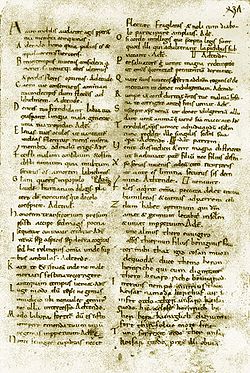Medieval Latin literature
| Medieval Latin | |
|---|---|
| Latina Mediævalis | |

Carmina Cantabrigiensia, Medieval Latin manuscript
|
|
| Native to | Numerous small states |
| Region | Most of Europe |
| Era | Developed from Late Latin between 4th and 10th centuries; replaced by Renaissance Latin from the 14th century |
|
Indo-European
|
|
|
Early forms
|
Old Latin
|
| Latin alphabet | |
| Official status | |
|
Official language in
|
De facto in most Christian states during the Middle Ages |
| Language codes | |
| ISO 639-3 | – |
|
Linguist list
|
lat-med |
| Glottolog | None |

Europe, 1000 AD
|
|
Medieval Latin was the form of Latin used in the Middle Ages, primarily: as a medium of scholarly exchange; as the liturgical language of Chalcedonian Christianity and the Roman Catholic Church; and as a language of science, literature, law, and administration. Despite the clerical origin of many of its authors, medieval Latin should not be confused with Ecclesiastical Latin. There is no real consensus on the exact boundary where Late Latin ends and medieval Latin begins. Some scholarly surveys begin with the rise of early Ecclesiastical Latin in the middle of the 4th century, others around 500, and still others with the replacement of written Late Latin by written Romance languages starting around the year 900.
Medieval Latin had an enlarged vocabulary, which freely borrowed from other sources. It was heavily influenced by the language of the Vulgate, which contained many peculiarities alien to Classical Latin that resulted from a more or less direct translation from Greek and Hebrew; the peculiarities mirrored the original not only in its vocabulary but also in its grammar and syntax. Greek provided much of the technical vocabulary of Christianity. The various Germanic languages spoken by the Germanic tribes, who invaded southern Europe, were also major sources of new words. Germanic leaders became the rulers of parts of the Roman Empire that they conquered, and words from their languages were freely imported into the vocabulary of law. Other more ordinary words were replaced by coinages from Vulgar Latin or Germanic sources because the classical words had fallen into disuse.
Latin was also spread to areas such as Ireland and Germany, where Romance languages were not spoken and had never known Roman rule. Works written in the lands, where Latin was a learned language with no relation to the local vernacular, also influenced the vocabulary and syntax of medieval Latin.
...
Wikipedia
